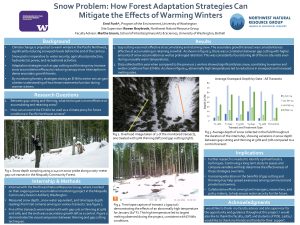Snow Problem: How Forest Adaptation Strategies Can Mitigate the Effects of Warming Winters
Expanding the utilization of forest thinning and gap cutting techniques in Washington’s woodland ecosystems could offer promising solutions to enhance the snow accumulation process. By limiting snow interception from dense second growth canopies, these methods could bolster forest resiliency, mitigating the effects of climate change. Snow accumulation is a cornerstone resource throughout Washington state, pivotal for ensuring water security, sustaining agricultural production, powering hydroelectric infrastructure, and facilitating recreational activities. This study was part of a collaborative internship with the Northwest Natural Resource Group (NNRG) during winter of 2024. The objective of the research was to assess the efficacy of gap cut and thinned forested areas in promoting snow retention relative to untreated second-growth forests within the Nisqually Community Forest in Ashford, Washington. To understand snow variance among different forestry techniques, data was collected along six separate transects each treated with varying percentages of either thinning or gap cutting as well an untreated control area. A comparative analysis between data collected this season and from prior years revealed positive trends correlating snow accumulation with the implemented forestry adaptation strategies. Notably, gap cutting was the most effective treatment for harboring snow, followed by fifty percent thinning and seventy percent thinning. In contrast, untreated second growth forest exhibited the least amount of snow accumulation and retention throughout the duration of the project. The absence of effective forestry adaptation strategies could leave Washington’s forests and the essential functions that rely on seasonal snowpack vulnerable to the escalating impacts of warming winters in the region.
